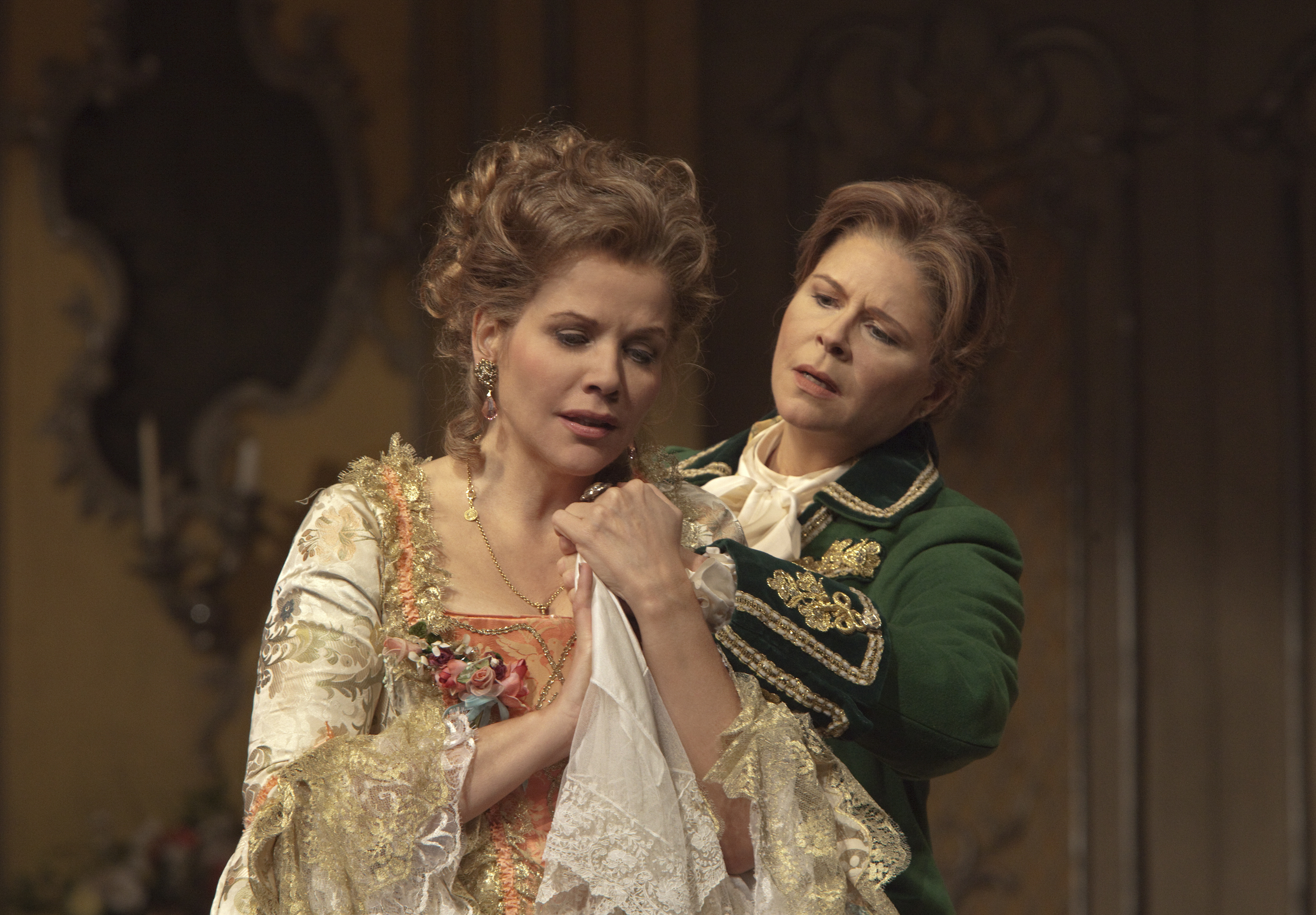
What tunes make your brain happy? An opera diva and a neuroscientist want to know
Photo: Ken Howard/Metropolitan Opera
On Sept. 11, opera singer Renee Fleming, seen here (left) in the 2009 Metropolitan Opera’s production of “Der Rosenkavalier” opposite Susan Graham (right), gave a lecture at Libby Gardner Hall discussing the connections between music, health and the brain.
It was two years ago that a dinner party brought an unlikely group of people together.
At one table sat renowned opera diva Renée Fleming, National Institutes of Health Director Francis Collins, and three Supreme Court justices: Anthony Kennedy, Ruth Bader Ginsburg and Antonin Scalia.
The judges had just come off the bench after making some tough decisions, and “there was not a lot of eye contact between them that evening,” Fleming joked to an enthusiastic crowd at the University of Utah’s Libby Gardner Hall on Monday, Sept. 11.
To help everyone unwind and relax, Collins took out his guitar, and an impromptu sing-along soon followed.
Although Fleming may slightly regret that the group didn’t follow through with their plan to go on tour as “The Supremes,” she’s grateful for that unusual gathering because it created the opportunity for her to work closely with Collins, exploring the crossover between their respective fields of music and science.
Fleming shared this story Monday afternoon with a large audience as part of a lecture about the connections between music, health and the brain. She was joined by University of Utah Health’s Norman Foster and Jeffrey Anderson. All three discussed how scientists are starting to understand the way the brain processes music, and expressed hope that this understanding will galvanize the field of music therapy.
Earlier this year, Fleming herself participated in a study at the National Institutes of Health. For two hours, the soprano alternated between speaking lyrics, singing lyrics and imagining that she was singing. After the study, the scan revealed that compared to speaking, more areas of the brain were active when Fleming was either singing or imagining that she was singing.
In a brief interview following the presentation, Fleming shared how music has always been an important part of her life.
“I grew up with a family of singers, and we would be in a car singing the street signs — in harmony,” she said. “And I thought everyone did that. … It’s just a part of the fabric of my life.”
Expressing gratitude for this upbringing in her presentation, Fleming explained that childhood music instruction can be beneficial for a child’s developing brain, especially in the areas of the brain responsible for processing sound, language development, speech perception and reading skills. She added that music also plays a role in social cohesion, helping to form connections and bonds between people.
The singer mentioned that throughout her career, she has been struck by music’s power to heal and transform lives.
“I have been genuinely touched by many heartwarming stories about how my music has brought people comfort in times of grief or illness,” she said.
A large portion of Fleming’s presentation included videos highlighting music’s therapeutic application for people suffering from traumatic brain injury, Parkinson’s disease, stroke and PTSD.
The story of Forrest Allen was one example of music’s therapeutic value.
In 2011, Allen, who was then 18, suffered a traumatic brain injury from a snowboarding accident that left him unable to talk or communicate.
After a year passed, Allen was able to type out this message to his childhood music teacher: “Help me get my voice back.”
Through melodic intonation therapy, Allen’s teacher-turned-therapist used singing to retrain his student’s brain. The therapy relies on melodic and rhythmic components to aid in speech recovery for those who have experienced damage and injury to language parts of the brain.
The final part of the event explored music’s therapeutic value and its implications for Alzheimer’s disease. Foster, who is a geriatric neurologist, explained that Utah has experienced the greatest increase of people suffering from the disease in the United States, and that currently, an estimated 50,000 Utah citizens are affected.
He pointed to a film titled “Alive Inside” that premiered at the Sundance Film Festival in 2014. The documentary highlights music’s ability to combat memory loss and shows how people can be revitalized through listening to music, according to the film’s website.
Anderson, who is the principal investigator for the Utah Functional Neuroimaging Laboratory, led an “Alive Inside” brain imaging project where he performed functional MRI scans on 20 people to show the effects of meaningful music on individuals with Alzheimer’s disease.
During each scan, he would play isolated, specific excerpts of music that had special meaning to each person. He would play the clip forward and then in reverse. The scan revealed that there was increased attention and brain activity when a familiar piece was played forward, showing a sense of recognition and a stimulation of memory. In addition, there were changes in brain connectivity after meaningful music was played, with certain areas of the brain becoming more synchronized. While revealing, such studies are only the beginning of understanding the powerful connection between music and the brain, Foster said.
Above all, Fleming hopes that this presentation will help to spread awareness about the power of music therapy.
“We are really hoping to validate this therapy in more meaningful ways,” she told the Deseret News. “It’s not quite consistent yet. It is in other countries, but in this country it’s not yet fully on the map.”
Monday afternoon’s presentation is linked to Fleming’s gala performance on Sept. 13 at Abravanel Hall. The performance celebrates Utah Opera’s 40th season, and will be a fundraising gala benefiting the organization’s education department.